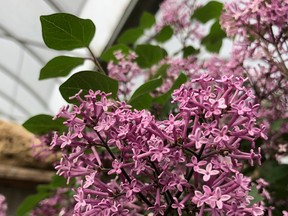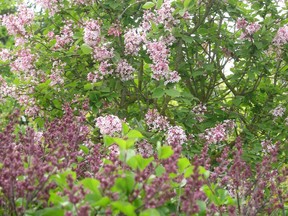Lilacs have long played an important role in the landscape, providing color in mid-spring and giving us an unmatched perfume.

Reviews and recommendations are unbiased and products are independently selected. Postmedia may earn an affiliate commission from purchases made through links on this page.
Article content
When we think about the perfume of our gardens, lilacs continue to be the favorites of romantics. Lilacs have long played an important role in the landscape, providing color in mid-spring, giving us an incomparable perfume and as a pollinator plant producing nectar and pollen for a wide range of beneficial insects. As the importance of growing cut flowers in the home garden increases, they have become more relevant, especially varieties that bloom a second time in late summer.
Advertisement 2
Article content
There are dozens of species of lilacs and thousands of cultivars ranging from one-meter ornamental plants to 10-meter trees. Many of the older varieties are no longer grown commercially in most nurseries today, but of these, the best known belong to the syringa vulgaris, or common lilac family, and form the basis of our newer varieties. . After hybridization, certain strains were improved and are now sold as French hybrids.
Article content
Most of these beautiful hybrids have large double flower clusters that are highly scented. The rich, deep purple-red, double-flowered Charles Joly is among the most sought after, as is the double white, Miss Ellen Willmott. Although it has a single bloom, the darker violet, Ludwig Spaeth, is a favorite, and the intense wine red and white bicolor of Sensation is stunning. There are countless beautiful varieties in a wide range of colors, and now even includes a soft yellow called Primrose.
These lilacs are some of our most winter-hardy plants and often tolerate Zone 2 temperatures. Once established, they are very drought tolerant and probably one of the least demanding plants you can choose for today’s gardens. Lilacs need full sun and some space to ensure good air circulation around them. They need well-drained soil and a good deep watering when necessary, but they don’t like wet feet.
Article content
Advertisement 3
Article content

They prefer a drier climate, but still perform well in coastal areas. In wet, rainy springs, they may contract some mildew and lilac blight, but will outgrow this once drier summer weather prevails.
Deadheading will encourage new growth and abundant flowering. Pruning annually, but only immediately after the first bloom of flowers in the spring, not in the fall, will keep the plants compact. A quick cleaning to remove misshapen, unproductive branches and any shoot growth should be sufficient.
If you’re looking for something one-of-a-kind, consider the Ivory Silk syringa reticulata, also known as the Japanese lilac tree. Growing taller and wider than most other lilacs, it requires space, so consider it as a grass specimen that can be pruned to maintain a single stem. This stunning tree produces huge, foot-long panicles of creamy white flowers in late June that will perfume your entire garden. Throughout the summer, the tree is densely covered with beautiful dark green leaves, and in autumn and winter the dark reddish-brown bark adds interesting dimension and texture to the winter landscape. It is basically problem-free and to top it off, Ivory Silk is suitable for zones 3 to 7 and is able to withstand sub-zero temperatures.
Advertisement 4
Article content

Nowadays, in our smaller gardens, new compact varieties have become very popular. Some of the oldest are the so-called Korean varieties, syringa pubescens, particularly Miss Kim. They have masses of unique, highly scented lavender flowers borne on plants that can reach up to two metres, but can easily be kept pruned lower to fit into tight spaces. Many have been grafted onto 1.5 to 2 meter stems to create attractive standard tree forms, ideal for containers or as focal points in the garden. I find them to be very clean plants with few insect or disease problems.
Korean lilacs have been available for several years, but Proven Winners has created a very compact, single-flowered variety for their Bloomerang series, which is now the number one lilac in today’s gardens. They grow naturally into rounded bushes up to a meter high. Vigorous and disease-resistant, they outperform conventional lilacs with perfect blooms in shades of lavender, purple or pink that cover the plant in spring and then again all summer and fall, even until the first frost.
Advertisement 5
Article content
As a garden writer, I received a specimen plant of Bloomerang Dark Purple when they were first introduced many years ago. It bloomed with very fragrant single light purple flowers the first year and settled quite well. At the end of August it bloomed again from top to bottom. What a pleasure to have that fragrance and a platter of cut flowers on those hot summer days.
Considered the most fragrant of the dwarfs, s. meyeri Palibin, is actually a lilac-colored Chinese variety that grows over a meter tall with light purple buds that open to white.
A recent introduction to the world of lilacs is a series called Flowerfesta. It is also a compact variety with highly scented individual flowers and the advantage of having the habit of reblooming late. Like their other compact single-flowered cousins, they are very heat and drought tolerant. They also have cold tolerance in Zone 3, making them viable in a wide range of garden locations throughout the province and, indeed, throughout the country.
Just think of the possibilities: as well as being suitable for containers, they will also make a nice low, easy-care hedge; They provide a long season of cut flowers and are also pollinators and hummingbird attractors. Although I have not personally had the opportunity to evaluate their flowering habit yet, they are reported to bloom much longer in their initial flowering stage in May, as well as repeat flowering in late summer.
Advertisement 6
Article content
These and other newer, more compact varieties fit very well into small gardens and most garden stores have a good selection this time of year, so perhaps consider adding them to your landscape this spring.
Bookmark our website and support our journalism: Don’t miss the news you need to know – add VancouverSun.com and LaProvincia.com to your favorites and subscribe to our newsletters here.
You can also support our journalism by becoming a digital subscriber — for just $14 a month, you can get unlimited access to The Vancouver Sun, The Province, National Post and 13 other Canadian news sites. Support us by subscribing today: The Vancouver Sun | The province.
Article content
